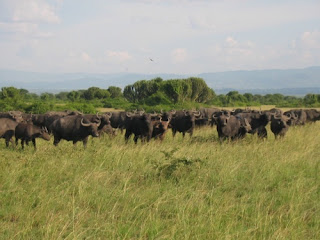I’m back in harness, although not yet pulling any heavy weights as I have just completed the first week of my post knee-replacement surgery. Of course this gives me plenty of opportunity to catch up on reading and to think about the trip that my family and I completed just before Christmas. We took our daughter, her husband and their two daughters to Kenya for three weeks and combined visits to a long list of old friends with trips to several game parks.
Like many visits it was mostly great, but there was one very sad thing we found out and another that I learned as soon as we got home. Both concern the destruction of game parks by massive and indiscriminate grazing of livestock.
One of our oldest friends had not long returned from a trip to Meru Game Park, a place that is dear to me for many reasons. I have written about it and its future in both of my Africa books because it was there that I launched my career as a wildlife veterinarian when I treated my first white rhino. I even managed to scan a section of the old map of this park in Wrestling With Rhinos and share it here - or had intnded to until I discovered that my entire blog program has suffered some sort of major health attack, or maybe it has bene hacked. I had other pictures I wanted to share, but they too would not upload.
Nigel and his wife had not only visited the park’s most western areas, but had gone all the way to the Tana River and been at first confused and then horrified at what they saw. The first impression was that the maze of footprints they had seen were those of cattle, but when they came across a massive herd of about a thousand buffalo they felt better.
The situation was temporary. As they approached the river, and left the more heavily patrolled and “popular” areas of the park near the very upmarket lodge Elsa’s Kopje, which lies within a long stone’s throw of George Adamson’s old camp, they realized that things were in bad way. Much of the bush had been cut with pangas and laid on the ground, where goats had consumed all the greenery. Many of the vehicle tracks were littered with brush and the huge fig tree at Adamson’s Falls had been shorn of almost all of its greenery. Nigel took a different route out of the park through the Ura gate and the destruction changed not one whit. The eastern half of the park was completely overrun with domestic livestock.
This is simply an escalation of the situation that warden Mark Jenkins had faced in the last days of his tenancy as the park warden. In The Trouble With Lions I predicted that Meru might not last as a park. Is this the beginning of the end?
I had hoped that this might be an isolated case, but I was quite wrong. Among the pile of magazines waiting for us at home was the October-December 2011 issue of Swara, the public face of the East African Wildlife Society. There are numerous conservation articles in its 68 pages, but the first thing I read was a long four-column letter from Dave Mckelvie about an experience he had in the Masai Mara that almost matched that of Nigel in Meru. The local Masai herdsmen are taking their cattle into the reserve at night. He confirmed this by leaving camp one night and seeing “hundreds and hundreds of LED torches twinkling in the dark.” As Dave further wrote:
“The migration will come to the Marsh [the area Dave visited] expecting a feast and will leave disappointed and be pushed out by cattle. The tourists will be and are completely in the dark and oblivious to the devastation this overgrazing will bring.”
In both cases the human population explosion continues to exert relentless pressure on the whole of East Africa. Traffic is an utter shambles in Nairobi, more and more people crowd into less and less free space and national parks are bound to feel the pressure. Sad but true.
















































